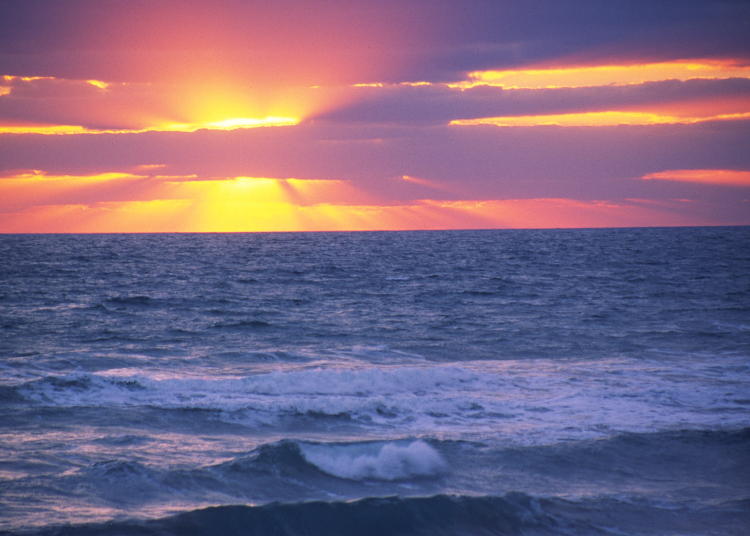
Some years back I created a collection of 5×7 prints in a matched boxed set, with mats and clear envelopes, so I had a portable gallery of images to show to publishers and art directors and all that – nicer presentation than a portfolio folder, easier to flip through. I selected a wide range of images, but concentrated on the fartsier ones instead of, you know, detail shots of cockroaches getting their insides sucked out, because I have the barest sense of aesthetics. And among them were these two frames from my time in Florida, nice beachy sunrises.
The fate of the boxed set was to sit on my shelves pretty much unmoving, because my meetings with publishers have been too few and far between, but more distinctly, the negotiations that I have had have taken place online or over the phone, with most of their exposure to my work coming through the website and through specific thumbnails that I sent over. I still like the boxed presentation, but no one gets to see it. Meanwhile, I have used these frames to illustrate something to my students, which I’ll get to shortly, so they’re in the instruction folder on my tablet.
As I was sorting through photos for another purpose recently, I started thinking that these two frames were not actually online anywhere, and double-checked the gallery to be sure: nope. A little surprising, but since we’re still in the slow season (the snow is now all gone and we’re back into rainy grey weather, bare trees, and brown grass,) they’re jumping in here for some color and content.

Both of these are slide film, by the way, and both from Indialantic Beach, Florida. In fact, from the exact same position, because they were taken only minutes apart, at radically different focal lengths – the bottom one was actually earlier than the top. It demonstrates how different something can look depending on how you frame it and what focal length is used, with a wide angle diminishing the details while giving a great impression of space, compared to the telephoto getting more color detail while enhancing those crepuscular rays. You can also see, if you look close at the clouds, that the exposures are slightly different because of the different areas of the sky and water that the meter was reading from (almost certainly the Evaluative Metering setting of Canon bodies, since these were definitely taken with the Elan IIe.)
What’s missing from the bottom one, however, while faintly visible in the top, is the layering of the clouds. In the bottom frame the clouds look more like flat pieces of lavender paper placed vertically in front of the sun, instead of thick blankets lying parallel to the earth’s surface, the light coming through at a very oblique angle. There was too little light underneath to show details or depth, so they’re largely silhouetted even though they have a decent color cast. Not a big deal of course, but it shows how easily the appearance can deviate from the reality.
Moreover, those little slots admitting the sunlight were remarkably narrow and selective. Go back up the the top one and notice that the sunlight, reaching me and the camera where I stood, did not touch the water more than a few dozen meters out, producing no shine at all beyond the breakers – it wasn’t actually visible from there. Might have been really interesting being aloft in a plane, looking down on the landscape and seeing how selectively the golden sunlight was touching it.




















































